Harry O’Brien; Footballer, Collingwood Magpies
This was a presentation I enjoyed even as I boggled. Part of me is an extremely cynical American who on the face of it took parts of his talk to be: I’m all about promoting myself above anything. The other part of me found him very genuine and thinking he probably did a lot of good work, promoted a lot of worthy causes and didn’t flaunt his efforts to make those charities about himself. There was a RMIT journalism student sitting at my table who was a huge fan of O’Brien. He asked O’Brien for his autograph and O’Brien was really nice about it. If you get the chance to hear O’Brien speak on this topic, it is worth it. He was asked to speak about social media from the athlete perspective.
- Denying social media is denying the multitude. Social media is a vehicle for sharing the message that you want to share.
- Why should athletes use social media? To share the message that you have. Harry was asked by Web Guru to contribute to the Collingwood site. This developed into his website, Harry’s World.
- Social media can effect positive change.
- If social media is good enough for Barack Obama and Julia Gillard, then it is good enough for him.
- Harry did his first interview in December 2004 after he was drafted. He used the interview with The Age to share is ideas and beliefs. He stands for sharing hope through positivity.
- Players complained to him about their privacy being violated. He thinks fans just want insight, glimpses into his life in a controlled manner.
- People started uploading pictures of him all over Facebook. He ran out of friends. He was overwhelemed. Then he moved to Twitter. He now loves Twitter. Then he started his own website, which was his dream: Having people here what he has to say.
- Social media is unfiltered. It gives you the essence of a person. He’ll always have insight into the Collingwood Football Club. He can share pictures, videos and eventually merchandise.
- People want Harry to speak! Social media allows him to share his message.
- Harry O’Brien doesn’t really follow sport stars on Twitter, but is aware of what they are doing. He has his own style and doew what he feels is right based on guidelines and a path.
- People are made u of energy. Science has proven it.
- Some one dated $50,000 to one of his charities after hearing about his work. He uses social media but he is not always aware of the real world impact of it.
- Harry O’Brien doesn’t care about other players ranting about service they get. O’Brien studied sociology. Just because you’re a sport person and society values that, it doesn’t mean you should be treated special. You should be proactive, not negatively complaining about bad service.
- O’Brien says football is his profession. Football is like the bait, so he can share his message. His football comments are so general that the club doesn’t have a problem with his activities. If the club wanted to use him more for inspiration, good luck to them as motivation should come from with in.
And that’s it. Those are all the presentations.
Related Posts:
Alana Fisher; Manager, Digital and Social Media (FIFA World Cup Bid), Football Federation Australia
This was another one of those presentations that I really found insightful as it explained how an Australian sport organization handled it. I was also able to contrast it with two of the state bodies that I’ve some familiarity with from having talked to their W-League representatives. There were some numbers that were really impressive but then put into the context of membership appeared less so. This doesn’t appear to a problem unique to the FFA though as an AFL club representative said that when you looked at the number of people who fan/like the team and then hide them from their feed, it can be shockingly high. I just didn’t take that many notes for this session as some of the numbers were a rehash.
- COI : Cost of Inactivity.
- You need a community manager. Community managers deal with content and moderation.
- They have over 160,000 people supporting their World Cup bid fan page.
- They have around 100,000 fans for the Socceroos on Facebook.
- They have a policy similar to that of Essendon regarding moderation.
- A good post has 250 comments.
- The coach decided to not allow players to use social media during the World Cup. FIFA also has their own guidelines for social media usage by players.
Nick Marvin; Chief Executive Officer, Perth Wildcats
I wasn’t expecting to take as many notes during this presentation as I did. The organization seems very on the ball with what they are doing. I really enjoyed this presentation.
- Marvin is not a sport guy. It is not his background.
- He has a sporting model based on the business model:
Top of triangle:
Member
Customer
Advocate
Fan
Prospect
Bottom of triangle.
- Winning isn’t everything. Engagement and tribal belonging are more important.
- Converting fans into paying customers: Specia deals on Twitter, discount codes. Target Perth Wildcat fans using e-mail.
- 51% of Facebook fans are likely to buy. 67% of Twitter followers are likely to buy.
- 35% of women are looking for deals online.
- CRM to SCRM: Need to move that way.
- Broad traditional media campaign is important to run but it is important to run that parallel to a social media and e-mail strategy.
- Going through social media, it allows:
1) Real time,
2) Direct/No intermediaries,
3) More authentic,
4) Less noise,
5) More frequent, and
6) Appropriate length.
- Social media allows real time feedback.
- The Perth Wildcats players sign a contract with the team for ethical behavior and community work.
- You need to monitor your brand.
- BackType and Social Mentions are two tools to help you monitor your brand.
- The Wildcats hire for character first. Character helps to build a brand.
- The Perth Wildcats use social media to monitor staff welfare. One person who the CEO saw tweet about feeling ill he talked to and suggested they go home if they are not feeling well.
Panel discussion: Nick Marvin, Jonathan Simpson, Jeramie McPeek, Alana Fisher
This was interesting but not as much interaction between panelists as there could be. It was at times more of a dialog with the audience. Still, lots of interesting things to learn from the panel.
- The Wildcats have increased their ticket prices 35% just to decrease the demand.
- The AFL is watching the NBA is doing and checking their own policies for online broadcasts as it relates to radio/audio.
- Steve Nash does his charity work quietly, without broadcasting it.
- Essendon has the best merchandising sales in the AFL. Essendon has a good situation as many advertisers approach them directly to cut their own deals, unlike other clubs who are hamstrung by the Telstra deal.
- Essendon encourages players not to look at comments. The club has talked with players about managing Facebook, and educating players in how to deal with social media.
- The Suns get in contact with Twitter people when people impersonate players and management.
- The AFLPA is working on snuffing out fake accounts on Facebook as they can be problematic.
- The Perth Wildcats CEO sat down and talked to a player who was slagged in the blogosphere.
Related Posts:
Jonathan Simpson; Digital Marketing Director, Essendon Football Club
I was really keen to hear from an AFL team about how they handled social media and fan engagement as this pertains to my research topic. It was one of the three presentations that I found most useful.
Social media needs to be a long-term strategy. Essendon created an action learning group specifically to address this issue.
Essendon has a virtual connection strategy group and a match day engage action learning group. Match day engagement was important considering the issue of venue sharing.
People need to be able to be multilingual, be able to explain ROI, know how to speak to and listen to fans. They need to be able to explain these issues to different audiences.
Essendon has 60,000 Facebook fans. Essendon has a department of Fan Develop. They brought in all the departments in the club and explained what this meant to them in order to get a corporate buy in across the system.
Essendon has been about allowing fans to follow them on the platform of their choice. That can be Facebook, Twitter, etc.
Social media is 24/7. You’ve got to be on it at all times. It gives voice to fans and as a member of a sport organization, you need to understand why this is important, why you’re doing that. It is a great opportunity to get feedback from fans.
You have to make money with social media and the web. It isn’t just about money though. It is about building sustainable long-term transactions and relationships with fans.
Facebook contests: Try to run them. Include forms for people to fill out. Use the data from Facebook contests to monetize the data.
Essendon has used Google Ad Words. It has an advantage that the results are trackable and much easier to manage in terms of ROI.
Essendon is the only team with an independent website.
The team has worked on trying to make it their multiteam stadium more personal and dedicated to their team. They do need an offline presence as community development works hand in hand with fan development.
In order to do social media in sport, you’ve got to love what you do.
Just get out there and do it. Roll with it. Try new things and measure the ROI. Then continue with what works.
Essendon was big with developing fan strategy.
6 or 7 people worked on the development team.
Social media needs to be more than just press releases.
Essendon shut down the Facebook fan page that was run by a fan. They had repeatedly try to contact the fan but they did not get a response. They felt that they had no choice but to take it over in the best interest of their fans.
Attempts at selling merchandise on Facebook have not been that successful.
Anthony Harrison; Digital Marketing Manager, Cricket Victoria
To be honest, I wasn’t that interested in mobile content and Harrison’s presentation. I can’t really get population data off of most of it. I can’t really track growth. It just doesn’t connect as much with what my interests are, except as platforms connect with places where I can get data.
There is 115% mobile penetration in Australia: People often have multiple phones.
There is 80% Internet penetration in Australia.
The Bushrangers find it a struggle in the Melbourne Market as it is really footy centric.
It is important to know your customer.
Peter Jakulovski; Managing Director, AFL Dream Team
This presentation was more interesting than the one on mobile content. I’ve just found it problematic at time to mine data from these types of sites and interest in fantasy football isn’t something I’ve always found translates into interest in a team. So for this speech, more notes than the last one but still not that many.
350,000 people are playing in the AFL Super Coach Fantasy Football League.
They play in head to had leagues, based on salary caps. Fans do not play using a draft style.
32.5% play fantasy sports to socialize with like minded sport fans.
52.3% play to compete.
Fantasy sport fans are male.
26% of players are under 18.
Fantasy sports is expanding to mobile platforms.
Two of the major fansites for fantasy AFL are fanfooty.com.au and dreamteamtalk.com.
Fans love interaction. They’ve been really successful with their iPhone application, which they sell for $3.99.
Super Coach and Dream Team can co-exist.
Finn Bradshaw; Chief Online Editor Sport and Racing, Herald Sun
This was a really interesting presentation from the perspective of a company that is trying to monetize interest in sport for their own purposes.
One guy originally looked after the Herald Sun and Super Footy websites. The attitude since the early website days has really changed.
Herald Sun sport are trying to get its reporters on Twitter and other social media sites.
Is technology killing newspapers? No. In the past, this may have been more true but not any more.
Super Footy gets 50% more traffic than the Age. Some of this is because people who are working for Super Footy really support the site.
For journalists, it really is about getting validity. Social media and the web can spread that along. Breaking news can be on a site quickly, as fast as 10 minutes.
Management needs to equip journalists with thick skins. 98% of people are nice but 2% are hugely problematic. Expectations need to be managed.
Break news and credibility are one thing that newspapers are good for. They are also good for a newspaper’s traffic.
You can’t sell your stories hard enough! Let users know what is there and why it is exciting.
Herald Sun traffic is growing.
WSJ has like a million subscribers.
Backing your own brand is very important.
US provides more opinion in the sport pages. Australia provides more information on players. The AFL gives more player access.
If teams/clubs can engineer unique content ideas, then the media may pick it up if they think the story can become viral. This is something important for smaller clubs and leagues in bigger, more congested media markets to realize.
Darren Rowse; Pro Blogger
A lot of this presentation was about monetization. When I went through my “Let me try to make Fan History into a legit start up!” phase, I learned a lot about this sort of thing. As a result, it felt like a lot of a rehash. Added to that, I found it a bit generic and not that applicable to most sport organizations. People I talked to really found it helpful though so my perspective may just be a bit jaded.
You don’t need credentials to be a blogger.
Related Posts:
These are my notes from the first two presentations.
Ed Wyatt; Journalist, SEN
Ed Wyatt was the first speaker. There were a couple of things I thought were worth noting.
Twenty years ago, the world was not digital but tape and typewriter. (We’ve come a long way in the past 20 years.)
Ed first got involved on Twitter about a year ago in order to help develop a digital media strategy for the South Dragons of the NBL. When the team folded, he changed the name of the account and took the followers with him.
The NBL digital platform limited some of the options available to the South Dragons. This included doing things like podcasts. The platform wasn’t flexible enough for their experimenting.He also showed a video. While I found his talk interesting, I was less impressed with the video as I had seen it, or a variant of it, before. These conferences have people with different skill sets so getting information that you already have isn’t unexpected. It just has its moments of annoying.
Jeramie McPeek; Vice-President of Digital Operations, Phoenix Suns
I probably took more notes for this speaker than any other because he gave a lot of specific examples of things that the team had done. It wasn’t an Australian speaker but he was able to talk about Australian fans of his team. His team’s history might also be interesting to contrast against Australian clubs.
20 years ago, there was no e-mail. People used memos through inter office mail. They also picked up the phone to call some one.
In January 1999, the NBA sent around a memo that said teams have to have a website. The original websites were outsourced. In 200, website management was brought back in house. In 2008, the NBA website was again outsourced to Turner Television, who had taken control of NBA.com. Teams still had control over their own sites.
TV Companion has helped improve during game website traffic for the Suns. It has also helped increase overall impressions and helped sponsors.
The NBA, through Turner Sports, has been good with mobile apps.
The Phoenix Suns are probably the strongest of all teams in the NBA when it comes to video. They were the first to include video on their site in 1997. They were the first to stream a press conference live on their site in 2004. They held the first talk show for their team in 2004. Fans find the behind the scenes video content useful. The club works to provide unprecedented access that that the press does not have.
The Suns had initial fears of putting content on other sites like YouTube. Originally they put content on MySpace and YouTube. In the fall of 2008, the club created their own social network, Planet Organge. The goal was to keep the fan community in house. One of the early purposes of social media was to drive traffic to in house sites.
Phoenix Suns fans from New Zealand and Australia met on the Suns network and did a ten game road trip to watch games at different locations, with the final game being one at home for the Suns. The team loved this and introduced the AU/NZ fans to the gorilla, the team and introduced them at a game.
In the past 18 months, traffic has been down to Planet Orange. This is possibly because the audience has shifted to Facebook.
The Shaq Effect on Twitter: November 2008 was when he got on. The Suns quickly followed suit. They use TwitPic to upload pictures. Fans love this type of inside access. The team also gives away tickets and other content on Twitter. They have used Twitter apps like TwitDraw to hold contests.
Interaction is key to the Phoenix Suns strategy. Social media is not a one way street. The team does random of “orange” where they give away things to their followers. Teams follow strategy is to follow people who say positive things about them.
The Suns have a Twitter roster: 8 players, 30 front office people, head coach, and assistant coach. They are ambassadors. The goal is to use these ambassadors to help build the brand. 150 total people outside the players work for the team and they are trying to get more on Twitter.
Players have not been recruited much to get on Twitter. Rather they got on it themselves in response to what they saw others doing. Players are also big users of text messaging.
Jared Pudley is a player who really does social media. He is on Twitter and uploads videos that appear on his stream. He does 10 second clips that give additional behind the scenes insight that fans like.
The NBA is up to 2 million followers on Twitter.
The Phoenix Suns took over the fan page on Facebook as originally it was run by a fan. They did this because they didn’t feel like they had a choice as they wanted to provide the best content for their fans. They gave the fan a lot of free stuff in exchange for the page. Unlike some teams, they did not pay the fan to run it for them. There was no drama involved in taking it over.
The Suns use Facebook like they use Twitter. They update less on Facebook because there is a different culture. They also find that they get more negative comments on Facebook than they do on Twitter. The Suns try not to moderate Facebook that much: If fans are respectful and negative, the comment can stay. If it is profane, overly personal and disrespectful, the comment will be deleted.
How do you measure ROI? The Suns are still not sure.
The Suns created their own Facebook application.
In January 2008, the Suns had the first Tweetup in the NBA. 100 people showed up. 250 people showed up to the second one, this when it had a higher price point for tickets.
Facebook night had 300 people show up to it.
All social media events are sponsored, which increases revenue streams for the Suns.
Teams are trying to figure out how to use Foursquare and Gowalla. The New Jersey Nets did a promotion with Gowalla. The Suns don’t have as many checkins as the MCG.
What’s next? The Suns do not know.
The Suns are the only team to have an analytics coordinator. The team also has a DB and e-mail manager.
The teams use demographics from social media sites when talking to sponsors.
Player use of intellectual property has been changing over the years. The NBA has been trying to help players more.
The Suns do not manager players usage of social media. There are guidelines in the NBA for players and teams like how many minutes before and after a game you cannot use social media. Individual teams also have their own guidelines. The Suns rules are based on common sense.I found this talk interesting, especially when contrasted to what I know of the rules and policies for player usage for the Socceroos, Canberra Raiders, Canberra United and Melbourne Victory. It was also interesting to hear how their usage of social media differed from these teams.
Related Posts:
On July 7, 2010, I attended the Digital Sport Summit held in Melbourne, Victoria. I was really excited to attend for several reasons. First, many of the speakers were from Australian sporting organizations. Some of the speakers represented clubs and the league I am doing my research on. Second, the topic involved social media. I love social media and better understanding how it is used from an organizational perspective because that can have an important impact on how fans organize themselves. Third, it was a chance to get out of Canberra. I love the people I’ve had an opportunity to talk to up here including the Canberra Raiders and Canberra United but the market conditions are really different than those that exist in other parts of Australia. I also love Canberra but I wanted to go some place where I could get from Point A to Point B and pass by several coffee shops. I also wanted to see the penguins. Lastly, I wanted a chance to meet some of the people I’d gotten to know on Twitter who have been helpful in teaching me more about Australian sport.
The speakers included Ed Wyatt, Jeramie McPeek, Anthony Harrison, Peter Jankulovski, Finn Bradshaw, Darren Rowse, Alana Fisher, Nick Marvin and Harry O’Brien. Below is a gallery of some pictures I took from my seat in the back (where I had a table to write on, could use Twitter on my iPhone with out being annoying, and where I could do data gathering during presentations I was less interested in). The next two or three posts will include notes from the various sessions I listened to. I’ve decided to put them into separate posts because one big post would be really difficult to read.
Before getting to those posts, I just wanted to say that the event was really fantastic. I got a chance to meet a few people from the AFL including two guys from the league and two guys from the Essendon Bombers. (And they were polite when I attacked them with HERE IS A PAPER AND DATA NOT ABOUT YOUR TEAM BUT TO SEE WHAT I CAN DO.) Some of the presentations answered questions I had regarding why data was acting the way it was and explained some of the decision making going on that impacts the fan experience. It also did this from an Australian sport perspective, with many presenters giving context for how this compared to American and European social media usage. They presented organization, the media and athlete perspectives. This was useful because it helped put all these pieces into a larger context for how the larger sport industry functions. If Anthony Alsop and co. put on the event again with a similar price point, I’d happily try to go again.
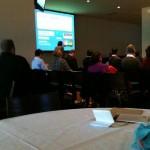

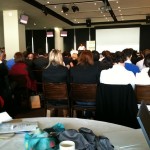
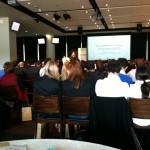
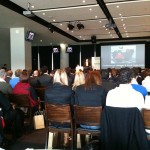
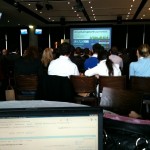
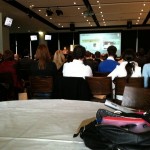
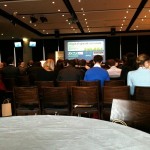


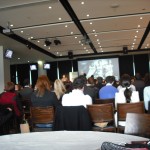
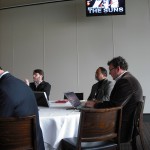
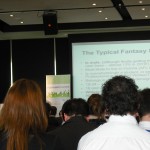

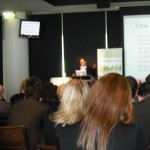


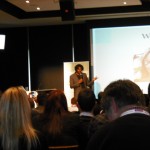
Related Posts:















